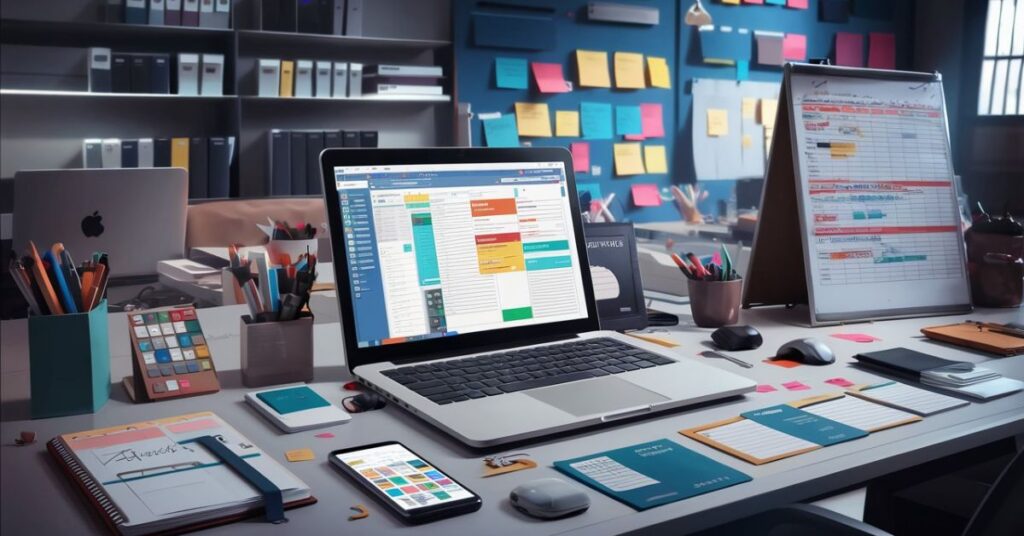In today’s fast-paced world, staying organized isn’t just a nice-to-have—it’s a must. Whether you’re a busy professional juggling multiple projects or an entrepreneur trying to keep your small business running smoothly, the question “What tools or technology do you use to stay organized?” is more relevant than ever. This comprehensive guide will explore the best organizational tools and technologies, helping you streamline your workflow and boost your productivity. What Tools or Technology Do You Use to Stay Organized?
Organizational Tools for the Office: Your Digital Decluttering Allies
The digital age has blessed us with a plethora of tools designed to keep our work lives in order. From simple to-do lists to complex project management software, there’s something for everyone. But with so many options, how do you choose?
Free Work Organization Tools That Won’t Break the Bank
Not every organizational tool needs to come with a hefty price tag. Here are some free options that pack a punch:
- Trello: A visual collaboration tool that uses boards, lists, and cards to organize projects.
- Google Calendar: A time-management and scheduling tool that’s seamlessly integrated with other Google services.
- Evernote: A note-taking app that allows you to capture, organize, and share notes from anywhere.
These tools offer robust features without costing a dime, making them perfect for individuals or small teams on a budget.
Why is Being Organized Important at Work?
Organization isn’t just about having a tidy desk—it’s a fundamental aspect of professional success. Let’s dive into why it matters so much.
1. It Gives You a Sense of Control
When your workspace (both physical and digital) is organized, you feel more in control of your tasks and responsibilities. This sense of control reduces stress and anxiety, allowing you to focus on what truly matters. What Tools or Technology Do You Use to Stay Organized?
2. Organization Promotes Better Communication
In a team setting, organization is key to effective communication. When everyone knows where to find information and how to track progress, collaboration becomes smoother and more efficient.
3. Being Organized Helps Achieve Goals
Organization is the bridge between setting goals and achieving them. By breaking down big objectives into manageable tasks and tracking your progress, you’re more likely to reach your targets.
4. It Improves the Ability to Focus and Make Decisions
A cluttered workspace leads to a cluttered mind. By organizing your environment and your tasks, you free up mental space for better focus and decision-making.
Break Free from Manual Data Entry
One of the biggest time sinks in any workplace is manual data entry. Automation tools can help you break free from this tedious task. For example, tools like Zapier or IFTTT can connect your apps and automate workflows, saving you hours of manual work. What Tools or Technology Do You Use to Stay Organized?
What Are the Fundamentals of Staying Organized at Work?
Before we dive into specific tools, let’s establish some fundamental principles of workplace organization.
1. Productivity and Time Management
Effective organization is built on a foundation of solid productivity principles. Some key concepts include:
- The Eisenhower Matrix: Prioritize tasks based on urgency and importance.
- The Getting Things Done (GTD) method: A five-step process for managing your workload.
- The 2-Minute Rule: If a task takes less than two minutes, do it immediately.
2. Organizational Habits and Routines
Consistency is key when it comes to staying organized. Develop habits like:
- Daily planning sessions
- Regular inbox cleanups
- Weekly review of goals and priorities
3. Workspace Structure and Organization
Both your physical and digital workspaces need structure. Consider:
- Using a file naming convention for digital documents
- Implementing a clean desk policy
- Organizing your computer desktop and email folders
What Are the Best Work Organization Tools?
Now, let’s explore some of the top tools in various categories that can help you stay organized.
1. Calendar and Planning Tools
A good calendar is the backbone of any organizational system. Some top picks include:
- Google Calendar: Great for personal and team scheduling
- Microsoft Outlook: Ideal for businesses using the Microsoft ecosystem
- Calendly: Perfect for easy appointment scheduling
2. Task Management Applications
Task managers help you keep track of your to-dos and deadlines. Popular options include:
- Asana: Excellent for team task management
- Todoist: A simple yet powerful personal task manager
- ClickUp: A versatile tool that combines task and project management
3. Project Management Software
For more complex work involving multiple team members and long-term goals, project management software is essential:
- Jira: Ideal for software development teams
- Basecamp: Great for general project management
- Trello: Perfect for visual project management
4. Note-taking and Document Management Tools
Keeping your thoughts and documents organized is crucial. Consider these tools:
- Evernote: A versatile note-taking app with powerful search capabilities
- Notion: An all-in-one workspace for notes, tasks, and databases
- OneNote: Microsoft’s robust note-taking solution
What Are Some Strategies for Managing Workload and Priorities?
Even with the best tools, you need solid strategies to manage your workload effectively.
1. Set Goals and Priorities
Use the SMART criteria (Specific, Measurable, Achievable, Relevant, Time-bound) to set clear goals. Then, prioritize your tasks based on these goals. What Tools or Technology Do You Use to Stay Organized?
2. Balance Collaborative Tasks and Individual Work
Use time-blocking to allocate specific periods for team collaboration and focused individual work. This helps maintain a balance and ensures you’re making progress on all fronts.
3. Maintain Focus and Minimize Distractions
Consider using techniques like:
- The Pomodoro Technique (25 minutes of focused work followed by a 5-minute break)
- Website blockers to limit access to distracting sites during work hours
- Noise-cancelling headphones to create a focused environment
How Do You Create an Efficient Workflow?
An efficient workflow is the key to sustained productivity. Here’s how to create one:
1. Implement Task Management Techniques
Consider methodologies like:
- Kanban: Visualize your workflow and limit work-in-progress
- Scrum: Break work into short sprints with regular check-ins
2. Adopt Project-based Management
Organize your work around projects rather than random tasks. This helps you see the bigger picture and understand how individual tasks contribute to larger goals.
3. Customize and Automate Workflows
Use tools like Zapier or Microsoft Power Automate to create custom workflows that automate repetitive tasks. What Tools or Technology Do You Use to Stay Organized?
How Do You Get Organized at Work When You’re Overwhelmed?
Feeling overwhelmed is common, but there are strategies to regain control:
- Use the Pomodoro Technique: Break your work into 25-minute focused sessions.
- Create To-Do Lists: Start each day by listing your most important tasks.
- Consider Time-blocking: Allocate specific time slots for different types of work.
- Delegate Your Tasks When Possible: Don’t hesitate to ask for help when needed.
- Embrace Technology in the Workplace: Use tools like RescueTime to track how you spend your time and identify areas for improvement.
How Do You Stay Organized at Work with Multiple Projects?
Juggling multiple projects can be challenging, but it’s doable with the right approach:
- Manage Your Tasks Separately: Use project management software to keep tasks for different projects distinct.
- Use Productivity Tools: Tools like Asana or Trello can help you visualize and manage multiple projects simultaneously.
- Step Away from Your Desk: Regular breaks can help you maintain perspective and avoid burnout.
- Focus on One Task at a Time: Resist the urge to multitask—it often leads to decreased productivity.
- Find a To-Do List Method That Works for You: Experiment with methods like the Bullet Journal or the 1-3-5 Rule to find what suits your work style.
What Are the Best Small Business Organization Tools?
Small businesses have unique organizational needs. Here are some tools tailored for smaller operations:
1. Free Small Business Organization Tools
- Wave: Free accounting and invoicing software
- Canva: For creating professional marketing materials
- Slack: For team communication and collaboration
2. Small Business Organization Tools for Receipts
- Expensify: For easy expense tracking and reporting
- Receipt Bank: Automates receipt and invoice processing
Conclusion
In conclusion, staying organized is a crucial skill in today’s fast-paced work environment. By leveraging the right tools and technologies, developing good habits, and implementing effective strategies, you can master the art of organization and boost your productivity. Remember, the key is to find what works best for you and your unique situation. Don’t be afraid to experiment with different tools and techniques until you find your perfect organizational system.
FAQs
A: It’s a good practice to do a weekly review of your tasks and goals, and a more comprehensive review of your overall system quarterly.
A: Yes, if you spend more time organizing than doing actual work. The key is to find a balance that enhances your productivity without becoming a task in itself.
A: Lead by example, provide training on organizational tools, and consider implementing team-wide systems for task and project management.






